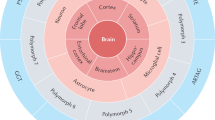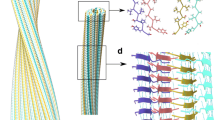Abstract
Abnormal protein aggregation or amyloid is the major cause of many neurodegenerative disorders. The present review focuses on the correlation between sequence and structure features of proteins related to the diseases and abnormal protein aggregation. Recent progress has improved our knowledge on understanding the mechanism of amyloid formation. We suggest a nucleation model for ordered protein aggregation, which can also explain pathogenesis mechanisms of these neurodegenerative diseasesin vivo.
Similar content being viewed by others
References
Spillantini, M. G., Schmidt, M. L., Lee, V. M. Y. et al., α-synuclein in Lewy bodies, Nature, 1997, 388: 839.
Koo, E. H., Lansbury, P. T. Jr., Kelly, J. W., Amyloid diseases: Abnormal protein aggregation in neurodegeneration, Proc. Natl. Acad. Sci. USA, 1999, 96: 9989.
Rochet, J. C., Lansbury, P. T. Jr., Amyloid fibrillogenesis: themes and variations, Curr. Opin. Struct. Biol., 2000, 10: 60.
Harper, J. D., Lansbury, P. T. Jr., Models of amyloid seeding in Alzheimer’s disease and Scrapie: Mechanistic truths and physiological consequences of the time-dependent solubility of amyloid proteins, Annu. Rev. Biochem., 1997, 66: 385.
Mezey, Z., Dehejia, A., Harta, G. et al., Alpha synuclein in neurodegenerative disorders: Murderer or accomplice, Nat. Med., 1998, 4: 755.
Narhi, L., Wood, S. J., Steavenson, S. et al., Both familial Parkinson’s disease mutations accelerate α-synuclein aggregation, J. Biol. Chem., 1999, 274: 9843.
Prusiner, S. B., Molecular biology and pathogenesis of prion diseases, Trends Biochem. Sci., 1996, 21: 482.
Patino, M. M., Liu, J. J., Glover, J. R., Lindquist, S., Support for the prion hypothesis for inheritance of a phenotypic trait in yeast, Science, 1996, 273: 622.
Perutz, M. F., Glutamine repeats and neurodegenerative diseases: molecular aspects, Trends Biochem. Sci., 1999, 24: 58.
Lansbury, P. T. Jr., Costa, P. R., Grifiths, J. M., Structural model for the β-amyloid fibril based on interstrand alignment of an antiparallel-sheet comprising a C-terminal peptide, Nat. Struct. Biol., 1995, 2: 990.
Zahn, R., Liu, A., Luhrs, T. et al., NMR solution structure of the human prion protein, Proc. Natl. Acad. Sci. USA, 2000, 97: 145.
Selkoe, D. J., Alzheimer’s disease: genotypes, phenotype and treatments, Science, 1997, 275: 630.
Polymeropoulos, M. H., Lavedan, C., Leroy, E. et al., Mutation in the α-synuclein gene identified in families with Parkinson’s disease, Science, 1997, 276: 2045.
Lashuel, H. A., Wurth, C., Woo, L. et al., The most pathogenic transthyretin variant, L55P, forms amyloid fibrils under acidic conditions and protofilaments under physiological conditions, Biochemistry, 1999, 38: 13560.
Davis, R. L., Shrimpton, A. E., Holohan, P. D. et al., Familial dementia caused by polymerization of mutant neuroserpin, Nature, 1999, 401: 376.
Hu, H. Y., Xu, G. J., Structural transformation, Prog, in Biochem. Biophys. (in Chinese), 1999, 26: 9.
Brooth, D. R., Sunde, M., Bellotti, V. et al., Instability, unfolding and aggregation of human lyzozyme variants underlying amyloid fibrillogenesis, Nature, 1997, 385: 787.
Jarrett, J. T., Lansbury, P. T. Jr., Seeding “one-dimensional crystallization” of amyloid: a pathogenic mechanism in Alzheimer’s disease and Scrapie? Cell, 1993, 73: 1055.
Suzuki, N., Cheung, T. T., Cai, X. D., An increased percentage of long amyloid β protein secreted by familial amyloid β protein precusor (βAPP717) mutants, Science, 1997, 264: 1336.
Author information
Authors and Affiliations
Corresponding author
About this article
Cite this article
Hu, H. Abnormal protein aggregation and neurodegenerative diseases. Chin.Sci.Bull. 46, 1–3 (2001). https://doi.org/10.1007/BF03183197
Received:
Issue Date:
DOI: https://doi.org/10.1007/BF03183197




